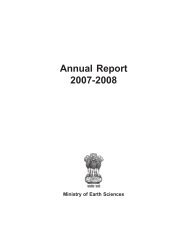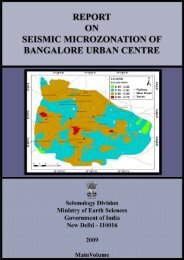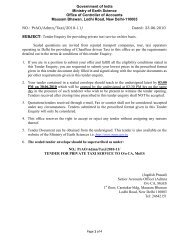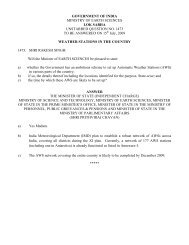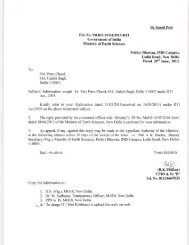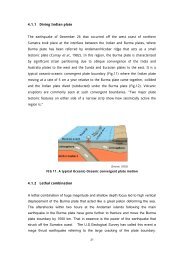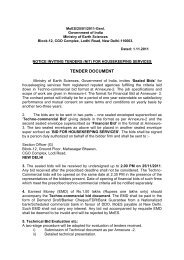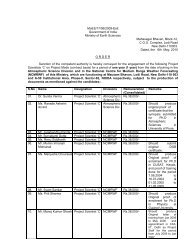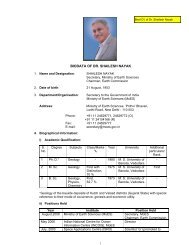Annual Report 2009-2010 - Ministry Of Earth Sciences
Annual Report 2009-2010 - Ministry Of Earth Sciences
Annual Report 2009-2010 - Ministry Of Earth Sciences
Create successful ePaper yourself
Turn your PDF publications into a flip-book with our unique Google optimized e-Paper software.
8<br />
Climate Change Science<br />
8.1 Introduction<br />
A coordinated research programme on Global<br />
and Regional Climate Change (GRCC) during the<br />
XI Plan has been launched to build a National<br />
Climate Change Monitoring and Research<br />
Network. A Programme <strong>Of</strong>fice is established at<br />
MoES Headquarters to operate GRCC Programme<br />
to integrate all envisaged activities in support of<br />
supplementing unified scientific response to the<br />
global warming launched by the Government of<br />
India under the National Action Plan on Climate<br />
Change (NAPCC).<br />
As a part of GRCC, a dedicated Centre for Climate<br />
Change Research (CCCR) to undertake studies on<br />
science aspects of Climate Change at the Indian<br />
Institute of Tropical Meteorology (IITM), Pune has<br />
been established. CCCR is focusing on all scientific<br />
issues, including modelling the susceptibility of<br />
various agricultural crops, yield and diseases,<br />
water, nitrogen, ozone, GHG flux measurements<br />
and CO 2<br />
cycle sequestration, etc.<br />
Recognising the importance of the critical and<br />
challenging science issues of climate change, and<br />
need to launch urgent focused efforts to deal climate<br />
change issue in a holistic and comprehensive<br />
manner, a National Workshop was held during<br />
18-19 May <strong>2009</strong> to discuss these issues threadbare<br />
and to build integrated national efforts.<br />
Representatives of various institutions that have<br />
participated in the National Workshop have<br />
appreciated the efforts of MoES in launching a<br />
dedicated programme on GRCC during the current<br />
five-year plan along with the establishment of<br />
a new CCCR in the IITM, Pune Campus with all<br />
necessary infrastructures.<br />
Update on the CCCR Establishment<br />
• CCCR incubation centre was established in<br />
October <strong>2009</strong> in the campus of the Indian<br />
Institute of Tropical Meteorology (IITM), Pune.<br />
• A new HPC facility with 7.2 Terra Flops (TF)<br />
peak- performance is commissioned and made<br />
fully functional.<br />
• A nucleus of 14 identified IITM scientists (1-<br />
Scientist-‘E’; 5-Scientist-‘D’s; 4-Scientist-‘C’s<br />
and 4-Scientist-‘B’s), apart from designated In-<br />
Charge, have already been grouped to work on<br />
envisaged CCCR activities. In addition, six new<br />
scientists (2-Scientist-‘E’s and 4-Scientist-‘C’s)<br />
are recruited. In summary, present CCCR staff<br />
comprises 20 Scientists (six new recruitments<br />
and a nucleus of 14 scientists from IITM). A<br />
visiting scientist position has recently been<br />
offered for strengthening the activities further.<br />
• A focused and well-defined roadmap for<br />
contributing to the Assessment <strong>Report</strong>-5 (AR5)<br />
of the Intergovernmental Panel on Climate<br />
Change (IPCC). Ensembles of regional model<br />
simulations are planned for downscaling<br />
the monsoon variability projections over the<br />
South Asian region. This will be the first time<br />
that projections based on model simulations<br />
conducted from India would be participating<br />
in the IPCC assessment.<br />
• Ability to capture summer monsoon<br />
characteristics over South Asia within<br />
17-ensemble member 20 th Century simulations<br />
of Quantifying Uncertainty in the Model<br />
Projections (QUMP) involving United<br />
Kingdom’s Hadley Centre Coupled Ocean-<br />
Atmospheric Climate Model version 3 (Had<br />
CM3) is examined to select potential ensemble<br />
member fields, among the 17, which have<br />
most closely reproduced the observed summer<br />
monsoon climate variables.<br />
50 <strong>Ministry</strong> of <strong>Earth</strong> <strong>Sciences</strong> : <strong>Annual</strong> <strong>Report</strong> <strong>2009</strong>-10





